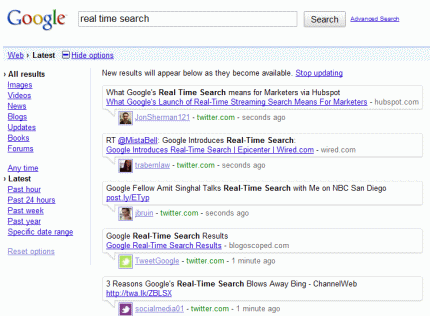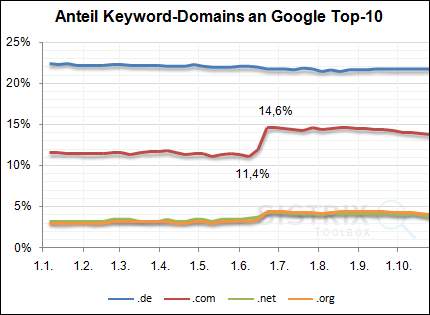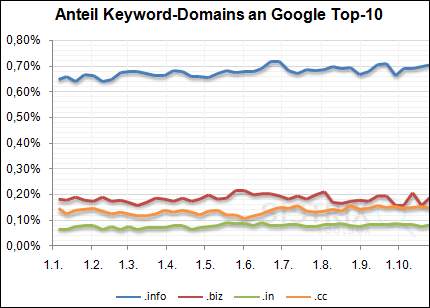Ya es celebre el numero 200 en lo que se refiere a los diferentes factores que Google evalúa en una página web para posicionarla en su índice.
Siempre los ingenieros de Google mencionan que existen muchos factores – más de 200 – para valorar una página web, y así de esta manera tratan de desvalorizar temas especificos que siempre son discutidos por los SEOs, cómo por ejemplo la importancia del PageRank, o el nombre del dominio.
Ahora en Search Engine Journal se han dado el trabajo de catalogar los 200 parámetros del algoritmo de Google.
Bueno, solamente han encontrado 130, y aquí les presento la lista:
Domain: 13 factors
Domain age.
Length of domain registration.
Domain registration information hidden/anonymous.
Site top level domain (geographical focus, e.g. com versus co.uk).
Site top level domain (e.g. .com versus .info).
Sub domain or root domain?
Domain past records (how often it changed IP).
Domain past owners (how often the owner was changed)
Keywords in the domain.
Domain IP.
Domain IP neighbors.
Domain external mentions (non-linked)
Geo-targeting settings in Google Webmaster Tools
Server-side: 2 factors
Server geographical location.
Server reliability / uptime
Architecture: 8 factors
URL structure.
HTML structure.
Semantic structure.
Use of external CSS / JS files.
Website structure accessibility (use of inaccessible navigation, JavaScript, etc).
Use of canonical URLs.
“Correct” HTML code (?).
Cookies usage.
Content: 14 factors
Content language
Content uniqueness.
Amount of content (text versus HTML).
Unlinked content density (links versus text).
Pure text content ratio (without links, images, code, etc)
Content topicality / timeliness (for seasonal searches for example).
Semantic information (phrase-based indexing and co-occurring phrase indicators)
Content flag for general category (transactional, informational, navigational)
Content / market niche
Flagged keywords usage (gambling, dating vocabulary)
Text in images (?)
Malicious content (possibly added by hackers).
Rampant mis-spelling of words, bad grammar, and 10,000 word screeds without punctuation.
Use of absolutely unique /new phrases.
Internal Cross Linking: 5 factors
Number of internal links to page.
Number of internal links to page with identical / targeted anchor text.
Number of internal links to page from content (instead of navigation bar, breadcrumbs, etc).
Number of links using “nofollow” attribute. (?)
Internal link density.
Website factors: 7 factors
Website Robots.txt file content
Overall site update frequency.
Overall site size (number of pages).
Age of the site since it was first discovered by Google
XML Sitemap.
On-page trust flags (Contact info ( for local search even more important), Privacy policy, TOS, and similar).
Website type (e.g. blog instead of informational sites in top 10)
Page-specific factors: 9 factors
Page meta Robots tags.
Page age.
Page freshness (Frequency of edits and
% of page effected (changed) by page edits).
Content duplication with other pages of the site (internal duplicate content).
Page content reading level. (?)
Page load time (many factors in here).
Page type (About-us page versus main content page).
Page internal popularity (how many internal links it has).
Page external popularity (how many external links it has relevant to other pages of this site).
Keywords usage and keyword prominence: 13 factors
Keywords in the title of a page.
Keywords in the beginning of page title.
Keywords in Alt tags.
Keywords in anchor text of internal links (internal anchor text).
Keywords in anchor text of outbound links (?).
Keywords in bold and italic text (?).
Keywords in the beginning of the body text.
Keywords in body text.
Keyword synonyms relating to theme of page/site.
Keywords in filenames.
Keywords in URL.
No “Randomness on purpose” (placing “keyword” in the domain, “keyword” in the filename, “keyword” starting the first word of the title, “keyword” in the first word of the first line of the description and keyword tag…)
The use (abuse) of keywords utilized in HTML comment tags
Outbound links: 8 factors
Number of outbound links (per domain).
Number of outbound links (per page).
Quality of pages the site links in.
Links to bad neighborhoods.
Relevancy of outbound links.
Links to 404 and other error pages.
Links to SEO agencies from clients site.
Hot-linked images.
Backlink profile: 21 factors
Relevancy of sites linking in.
Relevancy of pages linking in.
Quality of sites linking in.
Quality of web page linking in.
Backlinks within network of sites.
Co-citations (which sites have similar backlink sources).
Link profile diversity:
Anchor text diversity.
Different IP addresses of linking sites,
Geographical diversity,
Different TLDs,
Topical diversity,
Different types of linking sites (logs, directories, etc).
Diversity of link placements
Authority Link (CNN, BBC, etc) Per Inbound Link
Backlinks from bad neighborhoods (absence / presence of backlinks from flagged sites)
Reciprocal links ratio (relevant to the overall backlink profile).
Social media links ratio (links from social media sites versus overall backlink profile).
Backlinks trends and patterns (like sudden spikes or drops of backlink number)
Citations in Wikipedia and Dmoz.
Backlink profile historical records (ever caught for link buying/selling, etc).
Backlinks from social bookmarking sites.
Each Separate Backlink: 6 factors
Authority of TLD (.com versus .gov)
Authority of a domain linking in
Authority of a page linking in
Location of a link (footer, navigation, body text)
Anchor text of a link (and Alt tag of images linking)
Title attribute of a link (?)
Visitor Profile and Behavior: 6 factors
Number of visits.
Visitors’ demographics.
Bounce rate.
Visitors’ browsing habits (which other sites they tend to visit)
Visiting trends and patterns (like sudden spiked in incoming traffic)
How often the listing is clicked within the SERPs (relevant to other listings)
Penalties, Filters and Manipulation: 12 factors
Keyword over usage / Keyword stuffing.
Link buying flag
Link selling flag.
Spamming records (comment, forums, other link spam).
Cloaking.
Hidden Text.
Duplicate Content (external duplication)
History of past penalties for this domain
History of past penalties for this owner
History of past penalties for other properties of this owner (?)
Past hackers’ attacks records
301 flags: double re-directs/re-direct loops, or re-directs ending in 404 error
More Factors (6):
Domain registration with Google Webmaster Tools.
Domain presence in Google News.
Domain presence in Google Blog Search.
Use of the domain in Google AdWords.
Use of the domain in Google Analytics.
Business name / brand name external mentions.
Como se puede observar se trata de una lista bien exhaustiva y muy interesante que todo SEO tiene que conocer, pero también muchos de estos factores parecen ser un poco exagerados, por lo que no creo que todos estos parámetros sean realmente usados por el algoritmo de Google.
Pero por otra parte también esta lista demuestra que la aseveración de los ingenieros de Google sobre los más de 200 parámetros podría ser bastante exagerada.
Tal vez algún día podamos conocer la lista oficial de todos los factores que usa Google para analizar una página web…


